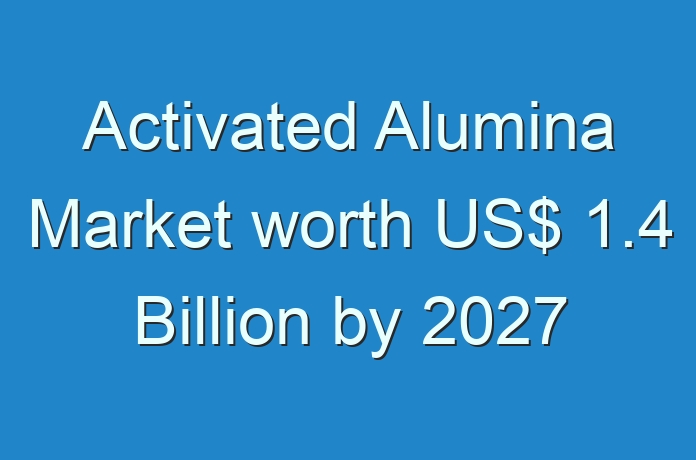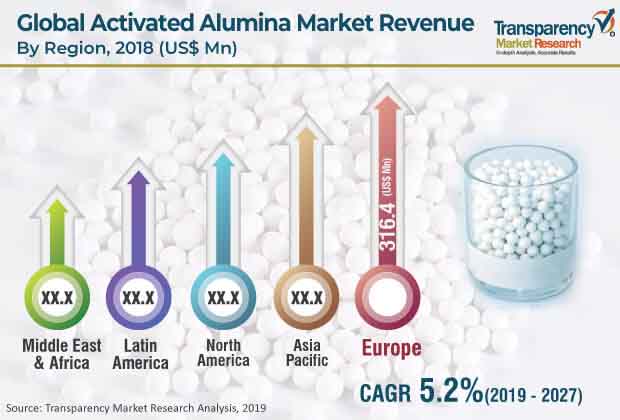
Activated Alumina Market – Snapshot
Stringent regulation regarding the fluoride, sodium fluoride, hydrogen fluoride, and fluorine contamination in water is anticipated to propel the activated alumina market during the forecast period. Institutes such as The International Agency for Research on Cancer (IARC) and the World Health Organization (WHO) monitor and regulate standards for fluorine contaminations in the water. Activated alumina is an extensively used to absorb fluoride, sodium fluoride, hydrogen fluoride, and fluorine impurities from the water. Activated alumina is a highly porous and granular form of aluminum oxide. It is used as desiccant, adsorbent, catalyst in oil & gas, water treatment, and chemical processing industries. Activated alumina is manufactured by dehydroxylating aluminum hydroxide. Activated alumina has high surface area, thus ensuring excellent adsorption abilities. Activated alumina is one of the widely used catalysts in the Claus process. It contains a large number of catalytically active sites; therefore, it is employed to absorb hydrogen sulfide and sulfur dioxide during the Claus process to yield elemental sulfur. It is widely used as a desiccant and adsorbent in the oil & gas industry. It is also extensively used in the removal of moisture from natural gas, removal of sulfur compounds, dehydration of high acid gas, dehydration of ethanol, purification of feedstock, separation of paraffin, and desulfurization of streams.

Request A Sample – https://www.transparencymarketresearch.com/sample/sample.php?flag=S&rep_id=3914
Rapid Growth of Water Treatment Infrastructure Industry to Fuel Activated Alumina Market
Water scarcity across the globe is one of the major global problems. Demand for water is increasing at substantial pace, as population across the globe increasing. According to a report published by the United Nations, 1.8 billion people are expected to be living in geographies with absolute water scarcity by 2050; therefore, to counter this problem governments across the globe are investing in water treatment infrastructure and technologies. For example, the Government of China allocates around US$ 110 Bn per year for environment protection and pollution control, which includes waste water treatment. Arsenic, lead, and fluoride are some major contaminants present in water streams. Activated alumina helps remove these contaminants effectively. Thus, increase in investments in wastewater treatment and water recycling are anticipated to drive the demand for activated alumina in the near future.
Leading Players Focusing on Geographical Expansion
Key players profiled in the activated alumina market include BASF SE, J.M. Huber Corporation, Honeywell International Inc., Sumitomo Chemical Co., Ltd., Axens, Porocel, Dynamic Adsorbents, Inc., KIN Filter Engineering Co., Limited, and Sorbead India. These players engage in collaborations, mergers & acquisitions (M&A), geographical expansion, and launch of new products. In March 2016, March 2016: Huber Engineered Materials acquired Albemarle’s Martinswerk Business. This acquisition increased the company’s market presence thus providing it with an edge over other market players.
More Trending Reports by Transparency Market Research – https://www.prnewswire.com/news-releases/global-paints–coatings-fillers-market-volume-to-reach-25-465-kilo-tons-by-2027-transparency-market-research-301007303.html
Beads Segment to Dominate Activated Alumina Market
In terms of form, the beads segment constituted a major share of the global activated alumina market in 2018. Activated alumina beads offer high surface area to mass ratio and are highly pours, which makes them a highly efficient absorbent in various applications. These beads are extensively used in the water treatment applications to the removal of impurities such as fluoride. They are used in the oil & gas applications to dehydrate compressed air and gases such as liquid petroleum gas (LPG) and compressed natural gas (CNG). The beads segment is estimated to expand at a rapid pace, due to high demand for water treatment infrastructure across the developing economies.
Demand for Activated Alumina to Increase in Water Treatment Application
In terms of application, the water treatment segment is projected to account for a significant share of the global activated alumina market during the forecast period. The segment is likely to expand at significant growth rate from 2019 to 2027. The oil & gas segment is anticipated to account for the dominant share of the activated alumina market. The gas dehydration sub-segment of the oil & gas segment is projected to expand at a considerable pace during the forecast period. Activated alumina offers diverse attributes such as high surface area to mass ratio and highly porous structure. These attributes make activated alumina a favorable material for oil & gas dehydration. Demand for activated alumina products in the water treatment industry is expected to rise due to extensive use of this material in water treatment plants.
Request For the Customization – https://www.transparencymarketresearch.com/sample/sample.php?flag=CR&rep_id=3914
Emerging Economies Dominating Activated Alumina Market
In terms of revenue, Asia Pacific leads the activated alumina market owing to the rise in investment in the water treatment infrastructure industry, which can be attributed to an increase in industrialization and urbanization in emerging economies such as China, India, and Japan. Increase in government investment in water treatment infrastructure and technologies and rise in demand for gases such as LPG and CNG have augmented the demand for activated alumina in the region. Asia Pacific is a prominent region of the market owing to the presence of a well-established industrial base, which continuously requires investment, in the region.
Request for covid19 Impact Analysis – https://www.transparencymarketresearch.com/sample/sample.php?flag=covid19&rep_id=3914





